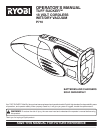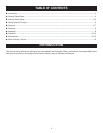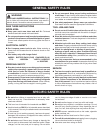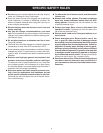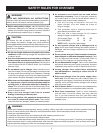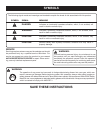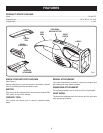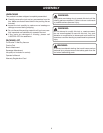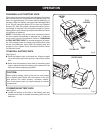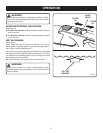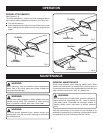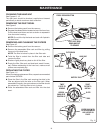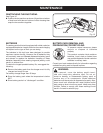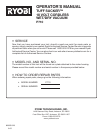
4 5
SPECIFIC SAFETY RULES
n Do not use to pick up hard objects such as nails, screws,
coins, etc. Damage or injury could result.
n Hand vac does not have to be plugged into an electrical
outlet, therefore it is always in operating condition. Be
aware of possible hazards when using the hand vac or
when changing accessories.
n Remove battery when the vacuum is not in use and
before servicing.
n Use only the charger recommended for your hand
vac. Do not substitute any other charger. Use of another
charger could cause batteries to explode causing pos-
sible serious injury.
n Do not place hand vac or batteries near fire or heat.
They may explode.
n The hand vac should be charged in a location where the
temperature is more than 50°F but less than 100°F.
n Under extreme usage or temperature conditions, battery
leakage may occur. If liquid comes in contact with skin,
wash at least 10 minutes then seek immediate medical
attention.
n Batteries vent hydrogen gas and can explode in the
presence of a source of ignition, such as a pilot light.
To reduce the risk of serious personal in jury, never use
any cordless product in the presence of an open flame.
An exploded battery can propel debris and chemicals. If
exposed, flush with water immediately.
n Know your power tool. Read operator’s manual care-
fully. Learn its applications and limitations, as well
as the specific potential hazards related to this tool.
Following this rule will reduce the risk of electric shock,
fire, or serious injury.
n To reduce the risk of electric shock, use the vacuum
indoors only.
n Always wear safety glasses. Everyday eyeglasses
have only impact-resistant lenses; they are NOT
safety glasses. Following this rule will reduce the risk
of serious personal injury.
n Protect your lungs. Wear a face or dust mask if the
operation is dusty. Following this rule will reduce the
risk of serious personal injury.
n Electric shock could occur if charged outdoors or on
wet surfaces.
n Check damaged parts. Before further use of the
tool, a guard or other part that is damaged should
be carefully checked to determine that it will operate
properly and perform its intended function. Check for
alignment of moving parts, binding of moving parts,
breakage of parts, mounting, and any other conditions
that may affect its operation. A guard or other part that
is damaged should be properly repaired or replaced
by an authorized service center. Following this rule will
reduce the risk of shock, fire, or serious injury.
n Save these instructions. Refer to them frequently and
use them to instruct others who may use this tool. If
you loan someone this tool, loan them these instruc-
tions also.



